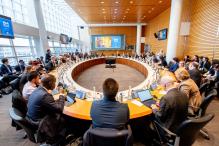Urban activities are responsible for 75% of global greenhouse gas emissions, making cities a key contributor to climate change. Additionally, cities are increasingly affected by climate impacts and disasters. Last week, UN Special Envoy Michael R. Bloomberg and the COP28 Presidency announced a partnership to tackle climate change ahead of the 2023 UN Climate Change Conference (COP28). The partnership foresees a key role for cities and local communities, states, regions and businesses.
Here are 5 reasons why cities deserve that spotlight at COP28:
In 30 years, two thirds of the global population will live in cities
By 2050, it is projected that more than two-thirds of the world population will live in urban areas. Latin America is already more than 80% urbanized. Urbanization brings challenges as well as opportunities that have to be accounted for in national and international policies. Over the last years, city networks and mayors have become powerful advocates of change.
An increase of 1.5°C would have devastating consequences for cities
According to the IPCC, with a temperature rise of 1.5°C, cities will likely have to deal with concepts such as food insecurity, water shortages, poverty, extreme weather events, diseases and other health impacts more often. For many coastal cities, associated rising sea levels would pose an existential threat. Also, densely-built cities exacerbate rising temperatures, exposing large groups to intensified and more frequent heatwaves that can even make cities uninhabitable.
The most vulnerable urban populations face the highest risks
Urbanization often brings challenges and injustices like shortages of affordable housing or basic services like waste management, as well as air and water pollution. The most disadvantaged urban groups are often living in the least favorable locations, such as on steep slopes or aside rivers. As a result, they are the most at risk while they are the least able to cope with consequences of climate disasters and impacts.
Cities are hubs of innovation and creativity
To ensure sustainable urban futures, the involvement of a diverse range of stakeholders is key. For example, Transformative Urban Coalitions (TUC), a project led by UNU-EHS and the World Resources Institute and supported by the International Climate Initiative (IKI), currently tests new models for coalition-building and governance to create more sustainable cities. Five "Urban Labs" integrate the visions and expertise of urban actors, practitioners and researchers to develop solutions to urban challenges that contribute to building zero carbon and socially just cities.
Rapid and inclusive transformation is needed for zero carbon cities
Achieving zero carbon emissions in cities will only be possible if coalitions driven by local communities are able to foster initiatives and demand decision-makers to implement strategies that lead to more resilient, sustainable and inclusive cities that also respond to the climate emergency. Using art and film can be a powerful tool to inspire new narratives to shift mindsets towards such urban futures that would benefit all inhabitants.



![smart2[1].png](https://unu.edu/sites/default/files/styles/card_view_small/public/2024-04/smart2%5B1%5D.png?itok=_-ZcLOM5)

